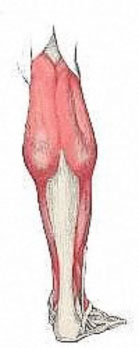ACHILLES TENDONITIS
 It is estimated that Achilles tendonitis accounts for around 11% of all running injuries. The Achilles tendon is the large tendon at the back of the ankle. It connects the large calf muscles (Gastrocnemius and Soleus) to the heal bone (calcaneus) and provides the power in the push off phase of the gait cycle. The Achilles tendon can become inflamed through overuse as well as a number of contributory factors. The Achilles tendon has a poor blood supply which is why it is slow to heal. Achilles tendonitis can be acute or chronic. Acute Achilles tendinitis may happen as a result of overuse or training too much too soon especially on hard surfaces or up hills.
It is estimated that Achilles tendonitis accounts for around 11% of all running injuries. The Achilles tendon is the large tendon at the back of the ankle. It connects the large calf muscles (Gastrocnemius and Soleus) to the heal bone (calcaneus) and provides the power in the push off phase of the gait cycle. The Achilles tendon can become inflamed through overuse as well as a number of contributory factors. The Achilles tendon has a poor blood supply which is why it is slow to heal. Achilles tendonitis can be acute or chronic. Acute Achilles tendinitis may happen as a result of overuse or training too much too soon especially on hard surfaces or up hills.
SYMPTOMS
- Pain on the tendon during exercise. Achilles pain will gradually come on with prolonged exercise but will go away with rest.
- Swelling over the Achilles tendon.
- Redness over the skin.
- You can sometimes feel a creaking when you press your fingers into the tendon and move the foot.
- Pain and stiffness in the Achilles tendon especially in the morning. This pain may be described as diffuse along the tendon rather than specific.
- There may nodules or lumps in the Achilles tendon, particularly 2cm above the heel.
- Pain in the tendon when walking especially up hill or up stairs.
- Chronic tendonitis differs from acute tendinitis in that it is more of a long term persistent problem.
WHAT CAN THE ATHLETE DO?
- Rest
- Stretch: Tight calves can put undue stress on the Achilles tendon
- Temporarily Alter Mechanics by putting heel lifts into the shoes. This is a catch 22 however because the point of adding the lifts is to alleviate pressure on the Achilles tendon by reducing the stress applied on it. However, by adding height under the heel, the calf and the tendon itself get shorter and may become tight at the new shortened length. Continue stretching.
- Massage: Further loosens tightness of the muscles, alleviating stress on the Achilles tendon.



